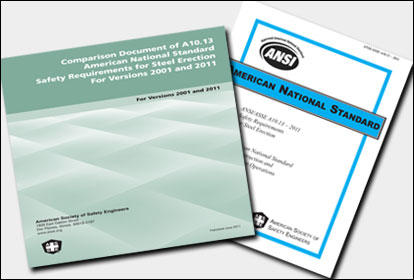OSHA interprets NFPA 70E questions from the field
Do these scenarios apply to your workplace?

 Question (1): Scenario: Employees will be using an insulated device to verify that an electrical circuit that has been "turned off, locked, and tagged" is de-energized. Are these employees required to use Personal Protective Equipment (PPE) under OSHA's construction standard 1926.416(a)(1) and/or NFPA 70E?
Question (1): Scenario: Employees will be using an insulated device to verify that an electrical circuit that has been "turned off, locked, and tagged" is de-energized. Are these employees required to use Personal Protective Equipment (PPE) under OSHA's construction standard 1926.416(a)(1) and/or NFPA 70E?
Answer: Section 1926.416(a)(1) provides: No employer shall permit an employee to work in such proximity to any part of an electric power circuit that the employee could contact the electric power circuit in the course of work, unless the employee is protected against electric shock by de-energizing the circuit and grounding it or by guarding it effectively by insulation or other means. [Emphasis added]
In your scenario, the employees are exposed to the hazard of electric shock since, at the time they are doing the work, a determination that the circuit has been de-energized has not yet occurred. Therefore, under this provision, these employees must be protected against electric shock "by guarding [the part] by insulation or other means." When so guarded, under this provision, PPE would not be required to protect against the electric shock hazard.
An additional hazard that may be associated with the work described in your scenario is that of arc flash. While Subpart K requirements have the effect of reducing the likelihood of an arc flash, Subpart K does not address the hazard that an arc flash poses to employees if it were to occur.2However, 29 CFR 1926.95(a) provides that:
Protective equipment, including personal protective equipment for eyes, face, head, and the extremities, protective clothing, respiratory devices, and protective shields and barriers, shall be provided, used, and maintained in a sanitary and reliable condition wherever it is necessary by reason of hazards of processes or environment, chemical hazards, radiological hazards, or mechanical irritants encountered in a manner capable of causing injury or impairment in the function of any part of the body through absorption, inhalation, or physical contact. [Emphasis added].
Industry consensus standards can be evidence that there is a hazard for which that PPE is "necessary." While the NFPA 70E consensus standard has not been adopted as an OSHA standard, it is relevant as evidence that arc flash is a recognized hazard and that PPE is necessary to protect against that hazard.
NFPA 70E Article 130 sets out alternative approaches for protecting against arc flash. One approach is to use an arc flash analysis to determine the Flash Protection Boundary; it calls for PPE to be used within that boundary.
An alternative approach is to follow a table that lists specific tasks and the PPE that is needed for each task. This approach is set out in Article 130.7(C):
Selection of Personal Protective Equipment.
(9)(a) When required for Various Tasks. When selected in lieu of the flash hazard analysis of 130.3(A), Table 130.7(C)(9) shall be used to determine the hazard/risk category for a task.
(10) Protective Clothing and Personal Protective Equipment Matrix. Once the Hazard/Risk Category has been identified, Table 130.7(C)(10) shall be used to determine the required personal protective equipment (PPE) for the task.
NFPA 70E's Table 130.7(C)(9)(a), Hazard/Risk Category Classifications, referenced above, lists the task, "Work on energized parts, including voltage testing" and assigns it a "Hazard/Risk Category" of "1" or higher. Under Table 130.7(C)(10), that categorization triggers various PPE provisions, including non-melting clothing, flame-resistant clothing, and other protective equipment. Thus, NFPA 70E is evidence that the industry recognizes the hazard of arc flash, that this hazard is present when testing voltage, and that, when present, it is necessary for PPE to be used to protect the employee from it.
Because the arc flash hazard varies with site-specific factors, we cannot determine from the information you provided the extent of the arc flash hazard in your scenario or the appropriate PPE. One way of ensuring that an employee is adequately protected is to use the NFPA 70E for assessing the factors in a specific situation and determining what protection to use.
Question (2): Scenario: Construction employees will be turning off circuit breakers. These circuit breakers, some of which are rated in excess of 240 volts (but not greater than 600 volts) and others less than 240 volts, are installed in three-phase panel boards contained within an approved enclosure with a bolt-on cover trim. The enclosure and cover trim prevent live parts from being exposed. Would the circuit breaker be considered an exposed electrical part when it has a closed cover trim installed such that PPE would be required to protect against electric shock when someone turns the breaker on or off? Would PPE be required to protect against arc flash?
Answer: The requirement in 1926.416(a)(1) to provide protection is triggered where an employee "could contact the electric power circuit." The circuit breaker you refer to is contained within an approved enclosure and has no exposed live parts. The enclosure and closed cover trim is a type of dead front design that does not expose employees to live parts. Therefore, electric shock protection is not required when simply turning the switch on or off.
Arc flash, however, may occur if the switch is defective. Employees in the scenario you describe may be exposed to risk when they are fixing the breaker or turning it on or off. while the chances of serious injury from arc flash may be remote in certain circumstances, NFPA 70E calls for a flash hazard analysis (or use of PPE under its table of tasks) to be performed in order to determine the risk level and the appropriate PPE. NFPA 70E 130.3 states:
A flash hazard analysis shall be done in order to protect personnel from the possibility of being injured by an arc flash. The analysis shall determine the Flash Protection Boundary and the personal protective equipment that people within the Flash Protection Boundary shall use.
(A) Flash Protection Boundary. For systems that are 600 volts or less, the Flash Protection Boundary shall be 4.0 ft, based on the product of the clearing times of 6 cycles (0.1 second) and the available bolted fault current of 50 kA or any combination not exceeding 300 kA cycles (5000 ampere seconds). For clearing times and bolted fault currents other than 300 kA cycles, or under engineering supervision, the Flash Protection Boundary shall alternatively be permitted to be calculated in accordance with the following general formula:
Dc = [2.65 x MVAbf x t]1/2
or
Dc = [53 x MVA x t]1/2
Where:
Dc = distance in feet from an arc source for a second-degree burn
MVAbf = bolted fault capacity available at point involved (in mega volt-amps)
MVA = capacity rating of transformer (mega volt-amps). For transformers with MVA ratings below 0.75 MVA, multiply the MVA transformer rating by 1.25
t = time of arc exposure (in seconds)
Once the risk of exposure is assessed, the employer must then provide PPE in accordance with the results of the analysis. NFPA 70E §130.3(B) states,
. . . The flash hazard analysis shall determine, and the employer shall document, the incident energy exposure of the worker (in calories per centimeter). . . Flame-resistant (FR) clothing and personal protective equipment (PPE) shall be used by the employee based on the incident energy exposure associated with the specific task. . . As an alternative, the PPE requirements of 130.7(C)(9) shall be permitted to be used in lieu of the detailed flash analysis approach described in 130.3(A).
As provided in the last sentence of section 130.3(B), NFPA 70E also provides an alternative analysis to determine PPE requirements. If the task to be performed has a high probability of arc flash occurrence, the charts under 130.7(C)(9) and (10) can be used to determine the appropriate PPE. Section 130.7(C)(9)(a) states in part,
When selected in lieu of the flash hazard analysis of 130.3(A), Table 130.7(C)(9)(a) shall be used to determine the hazard/risk category for a task. The assumed short-circuit current capacities and fault clearing timed for various tasks are listed in the text and notes to Table 130.7(C)(9)(a). For tasks not listed, or for power systems with greater than the assumed short-circuit current capacity or with longer than the assumed fault clearing times, a flash hazard analysis shall be required in accordance with 130.3.
Although this analysis uses a worst case scenario to determine the need for PPE, if the breaker has more than the assumed short-circuit current capacity or longer than the assumed fault clearing times, the charts will be of no use, and the flash hazard analysis under 130.3 would need to be done.
The employer must consider several factors in determining which analysis to perform. The risk of injury largely depends on the amount of energy available to the breaker, how old it is, how well it was maintained, and the task that is to be performed, among other factors. For example, a house with 240-volt service and a well-maintained breaker may typically have 10,000 amps available; in most such situations, there will be little arc flash risk when simply turning the switch on or off. In contrast, a commercial building with an equally well-maintained breaker typically will have 40,000 amps, which poses greater risk. In addition, switching a breaker on may carry more risk than turning a breaker off.
In sum, arc flash can be a significant danger under certain circumstances, and the provisions above are evidence of its recognition by the industry. One way for an employer to meet its obligations under 1926.95(a)4would be to use the NFPA 70E method of measuring the risk and determining the appropriate PPE. When using the arc flash hazard analysis approach, the employer may determine in some circumstances that, when turning off a breaker, there is little risk and no PPE is needed. However, all the relevant factors, including those referred to above, need to be considered. Alternatively, the employer may use the NFPA table instead of conducting the analysis, in which case some PPE would be required, even for the voltages below 240 V.
Looking for a reprint of this article?
From high-res PDFs to custom plaques, order your copy today!







